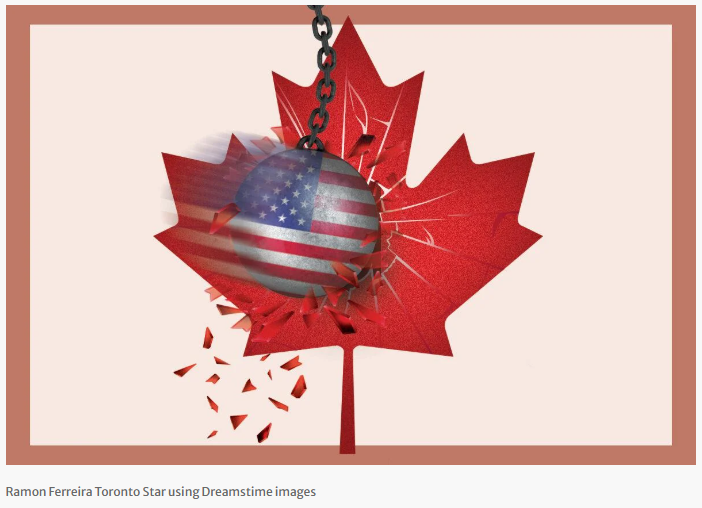By Ana Pereira | The Toronto Star
When U.S. President Donald Trump threatened to launch a full-blown trade war with its closest ally, many Canadians felt as if their best friend had suddenly turned around and stabbed them in the back.
Trump’s string of accusations, along with increasingly hostile suggestions that the U.S. annex Canada as “the 51st state,” have led many to pledge boycotts of American products. The majority of Canadians now support calling on the government to reduce our reliance on the U.S. as a trading partner, according to a recent poll by the Angus Reid Institute of more than 1,800 adults.
Patriotism aside, there are solid economic reasons why Canada might want to consider reducing trade with America, according to economists. Trump’s threats have introduced a major source of uncertainty in a decades-old trade partnership that saw Canada give up some of its independence in exchange for economic prosperity and stability.
It’s a relationship that has benefitted both economies, with nearly 80 per cent of Canadian exports currently ending up south of the border, but it was built on trust, and trade experts say that trust is now gone.
Is achieving a greater degree of economic independence from the U.S. really possible? Can we really undo decades of integration without seeing our economy crumble?
The Star spoke with economists, academics and other experts, including SCP CEO Matthew Mendelsohn, about how the country should best navigate this new era of Trump’s isolationism, and found there are realistic steps we can take to reduce our dependence on the States.

Share with a friend
Related reading
Mapping the economic centre-left
The large and well-funded American blogosphere has a pretty wide array of economic voices and ideological camps within the centre-left tent. So big, in fact, that there’s a sub-genre of inter-blog conflict dedicated to people named Matt. Over the years, SCP Director of Policy Dan Skilleter has found it useful to categorize these various different centre-left ideological camps in his head. The categories are not mutually exclusive, and most people probably identify with a few at once. This explainer breaks down each camp's story about what’s wrong with the economy and how they’d prioritize dealing with it.
How intergenerational inequality threatens trust in democracy | Policy Options
Our political leaders must be willing to make difficult tradeoffs to rebalance policies toward the young and away from older Canadians, write Jean-François Daoust, Liam O'Toole and Jacob Robbins-Kanter in Policy Options. The broader economic picture for younger Canadians offers little hope, and economic frustration is shown to run hand-in-hand with political alienation. As intergenerational inequality persists and deepens, Canada risks experiencing an even sharper decline in trust in its democratic institutions than what already exists. Building affordable housing and supporting young families are essential first steps in a much-needed generational reset that puts fairness at the centre of Canadian political life.
Smith School of Business launches new Employee Ownership Research Initiative
Smith School of Business at Queen's University is launching Canada's first-ever research initiative focused on deepening Canada’s knowledge and understanding of a powerful succession model that can enhance outcomes for owners, employees and communities: employee ownership. With funding support from Jon Shell, Chair of Social Capital Partners and a board member at Employee Ownership Canada, the Employee Ownership Research Initiative (EORI) will be housed in Smith’s Centre for Entrepreneurship Innovation & Social Impact (CEISI). The initiative will shape a made-in-Canada approach to employee ownership and create a multi-disciplinary network of academics, researchers, practitioners and businesses to fill gaps in relevant data, expertise and business-oriented resources to support employee-ownership activities across the country.


